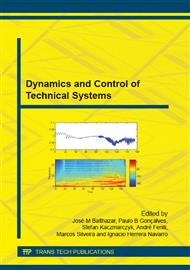p.128
p.137
p.149
p.159
p.170
p.181
p.191
p.206
p.222
Least Squares Method for Attitude Determination Using the Real Data of CBERS-2 Satellite
Abstract:
his work is applied to the dynamics of rotational motion of artificial satellites, that is, itsorientation (attitude) with respect to an inertial reference system. The attitude determination involvesapproaches of nonlinear estimation techniques, which knowledge is essential to the safety and controlof the satellite and payload. Here one focuses on determining the attitude of a real satellite: CBERS-2(China Brazil Earth Resources Satellite). This satellite was launched in 2003 and were controlled andoperated in turns by China (Xi’an Control Center) and Brazil (Satellite Control Center). Its orbit isnear polar sun-synchronous with an altitude of 778km, crossing Equator at 10:30am in descendingdirection, frozen perigee at 90 degrees, and providing global coverage of the world every 26 days.The attitude dynamical model is described by nonlinear equations involving the Euler angles. Theattitude sensors available are two DSS (Digital Sun Sensor), two IRES (Infra-Red Earth Sensor), andone triad of mechanical gyros. The two IRES give direct measurements of roll and pitch angles with acertain level of error. The two DSS are nonlinear functions of roll, pitch, and yaw attitude angles. Thegyros furnish the angular measurements in the body frame reference system. Gyros are very importantsensors, as they provide direct incremental angles or angular velocities. They can sense instantaneousvariations of nominal velocities. An important feature is that it allows the replacement of complexmodels (different torques acting on the space environment) by using their measurements to turn thedynamical equations into simple kinematic equations. However gyros present several sources of errorof which the drift is the most troublesome. Such drifts yield along time an accumulation of errorswhich must be accounted for in the attitude determination process. Herein one proposes to estimatethe attitude and the drift of the gyros using the Least SquaresMethod. Results show that one can reachaccuracies in attitude determination within the prescribed requirements, besides providing estimatesof the gyro drifts which can be further used to enhance the gyro error model.
Info:
Periodical:
Pages:
181-190
Citation:
Online since:
December 2014
Authors:
Price:
Сopyright:
© 2015 Trans Tech Publications Ltd. All Rights Reserved
Share:
Citation:


